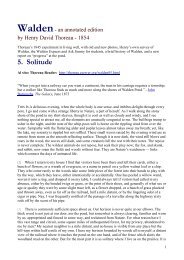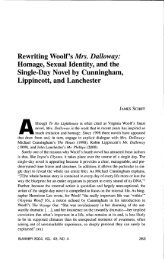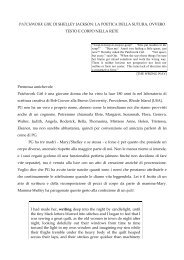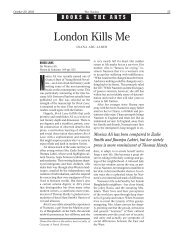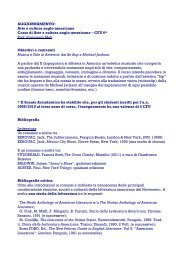Exciting Tales of Exotic Dark India - Paola Carbone
Exciting Tales of Exotic Dark India - Paola Carbone
Exciting Tales of Exotic Dark India - Paola Carbone
Create successful ePaper yourself
Turn your PDF publications into a flip-book with our unique Google optimized e-Paper software.
<strong>Exciting</strong> <strong>Tales</strong> <strong>of</strong> <strong>Exotic</strong> <strong>Dark</strong> <strong>India</strong> 277<br />
cultural difference” as a “general mechanics <strong>of</strong> exoticist representation/<br />
consumption within an increasingly globalized culture industry”. 7 Within<br />
this “alterity industry”, 8 one <strong>of</strong> the agents involved in the mediation <strong>of</strong> the<br />
“aesthetic value <strong>of</strong> cultural difference” 9 is the literary marketplace. It is my<br />
contention here that Adiga’s novel contributes (even if unintentionally) to<br />
sustain this alterity industry. The marketing potential <strong>of</strong> The White Tiger<br />
lies in two distinct but nevertheless related ideas – that <strong>of</strong> “the exotic”<br />
and that <strong>of</strong> “dark” – which are in turn associated with cultural difference.<br />
In this sense, the novel’s revamped spectacle <strong>of</strong> <strong>India</strong> is achieved through<br />
representational strategies that conflate an <strong>Exotic</strong> <strong>India</strong> with a <strong>Dark</strong> <strong>India</strong>.<br />
To demonstrate that Adiga’s <strong>Dark</strong> (<strong>Exotic</strong>) <strong>India</strong> is staged, this article<br />
begins by considering The White Tiger as an ironic uncovering <strong>of</strong> the<br />
subsumption <strong>of</strong> a <strong>Dark</strong> <strong>India</strong> into the global literary marketplace at a<br />
time <strong>of</strong> a perceived shift in re-Orientalist representational practices and<br />
their western reception. This reading was inspired by the (self-ironic)<br />
confession on the part <strong>of</strong> Adiga’s narrator that his knowledge <strong>of</strong> the history<br />
<strong>of</strong> <strong>India</strong>’s booming neighbour, China, came from a book – significantly<br />
entitled <strong>Exciting</strong> <strong>Tales</strong> <strong>of</strong> the <strong>Exotic</strong> East – he found when browsing<br />
at a secondhand book market in Delhi (p.5). This account <strong>of</strong> how the<br />
image <strong>of</strong> China in the protagonist’s mind was built around a book with<br />
that clichéd title might be interpreted both as a satire <strong>of</strong> exoticizing<br />
western notions about the East and as an exposure <strong>of</strong> the metropolitan<br />
consumer-reader’s complicitous desire for such alluring tales. Specifically,<br />
while taking the measure <strong>of</strong> the appraisals The White Tiger has received,<br />
this article questions the premises that underpin the most vehement<br />
critiques directed at the novel: on the one hand, that Adiga’s work <strong>of</strong>fers<br />
a purportedly long-awaited creative departure from Salman Rushdie’s,<br />
hence the awarding <strong>of</strong> the Booker in 2008; on the other hand, that the<br />
characterization strategies followed by the novelist result in what critics<br />
have perceived as class ventriloquism and, accordingly, in a construction<br />
<strong>of</strong> a re-Orientalized “cardboard cut-out” title character 10 equipped with<br />
an “inauthentic” voice that ultimately undermines issues <strong>of</strong> class politics.<br />
Rottenness and Corruption, Inc.<br />
In a nutshell, The White Tiger is about an <strong>India</strong> that is “two countries in<br />
one: an <strong>India</strong> <strong>of</strong> Light, and an <strong>India</strong> <strong>of</strong> <strong>Dark</strong>ness” (p.14). The <strong>India</strong> <strong>of</strong><br />
Light is that <strong>of</strong> wealth, technology and knowledge, while the <strong>India</strong> <strong>of</strong><br />
<strong>Dark</strong>ness (where the majority <strong>of</strong> <strong>India</strong>ns live) is that <strong>of</strong> misery, destitution<br />
and illiteracy. The novel describes how its protagonist/narrator Balram<br />
Halwai manages to claw his way into the Light <strong>of</strong> Delhi and Bangalore,<br />
out <strong>of</strong> the <strong>Dark</strong>ness <strong>of</strong> Laxmangarh, a small remote village in the poor<br />
state <strong>of</strong> Bihar, in eastern <strong>India</strong>, on the banks <strong>of</strong> what he calls the “the<br />
Downloaded from jcl.sagepub.com at Senate House Library, University <strong>of</strong> London on November 29, 2010



